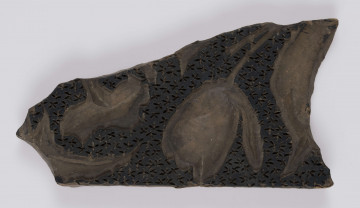
Block for printing on textile
1901 — 1950
National Museum in Lublin
Part of the collection: Fabric printing matrices
The presented printing stamp comes from the collection of the Pommersches Landesmuseum Stettin. It was most likely used in one of the local printing shops operating in Pomerania until the end of 19th or beginning of the 20th century. The stamp was used to cover the fabric with a uniform pattern, using a batik printing technique. As opposed to the block technique in which the ink is impressed directly onto the fabric, batik printing uses an insulating paste, the so-called resist, which protects the fabric from the effects of the dye when it is soaked several or more times. After removing the resist there is an unpainted pattern on the dyed background. The stamp was made with two boards joined together. It has nails in each corner which left small marks on the fabric when the stamp was pressed in it, so that the printer would know where to put the stamp again without losing the continuity of the pattern. The stamp has an ornament made of brass pins and small metal plates studded on wood, consisting of four parallel stripes made of stalks with multi-petal flowers. The pattern densely covers the surface of the block, but thanks to the fact that it is made of small metal elements, it is very light. The kinds of stamps were made rather late, only in the 19th century. Initially, the patterns were made in wood, but gradually they were enriched with small pins and plates which in time completely replaced the carved design.
Author / creator
Dimensions
cały obiekt: height: 5,3 cm, width: 20,8 cm
Object type
matrix
Creation time / dating
Creation / finding place
Identification number
Location / status

1901 — 1950
National Museum in Lublin

1901 — 1950
National Museum in Lublin

1901 — 1950
National Museum in Lublin
DISCOVER this TOPIC
Castle Museum in Łańcut
DISCOVER this PATH
Educational path